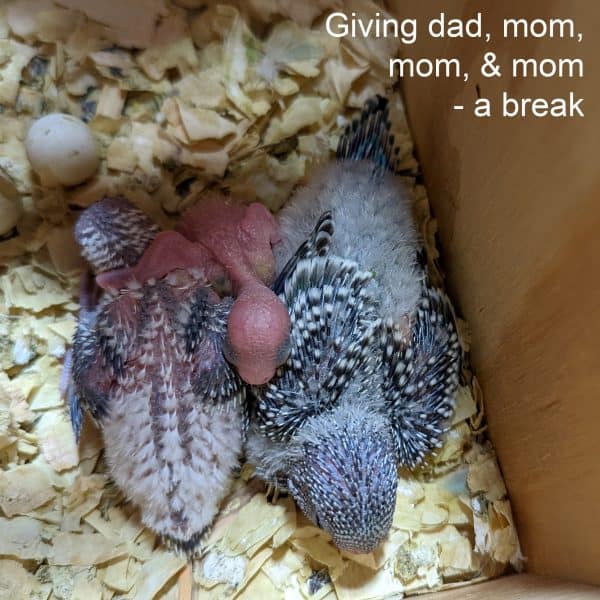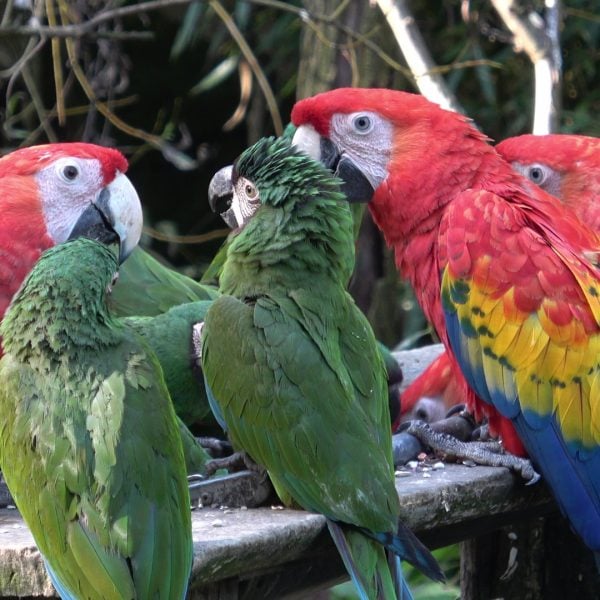Last Updated on by Catherine Tobsing
Barbara Writes,
I love the new format so much, Mitch.
And I have a question regarding the video of the cockatoo and sun conure. How do you know when it’s safe to let them be together like that?
You could see the cockatoo loved his friend the conure and enfolded him in his wing.
But I also know that cockatoo could turn on a dime.
At least that is what I always believed.
Maybe I’m wrong.
I spent time working at the Oasis and there was a famous story there.
Every day at sundown, the same caretaker went to kiss the same cockatoo good night.
This went on for ten years.
At the beginning of the eleventh year, the cockatoo tore most of the caretaker’s mouth off when he went to kiss him.
How do we as bird owners make these kinds of important decisions for our birds?
It’s so much better for them to have a bird buddy that they love but how do we safely and responsibly allow it?
Maybe it’s just knowing the bird well enough?
Especially if you’ve had it since it was a baby. Any information would help. Whenever you have time.
Thanks and happy new year to you and Catherine and all your dear birds.
Hi Barbara,
Thank you for the kind words and positive feedback.
You’re asking two questions but they will share the same answer and they both resolve to the area of trust.
Regarding the caregiver whose lip got torn off after seeing no problems for 10 years, my response will always be the same.
Birds should not be allowed near any human face. Not the caregiver not a family member not a child.
A parrot’s beak has razor blades and extraordinarily sharp tip. They can accidentally tear skin if say distracted by a loud noise.
Kissing your bird is not cute and you don’t want it to have access to human saliva (deadly bacteria).
Contact with the outer part of the beak could stimulate sexual feelings in your bird.
I see no positive outcome of kissing a bird on the beak. It is just a human affectation.
With regards to the video, because I’m a data guy, I bring that over to the bird side and test for everything.
In the video, we clearly have an older bird and a younger bird.
Younger birds are young and dumb making them more amiable to bonding as we see in the video.
You may not see the same outcome with say 2 alpha male adult Green wing macaws.
Two male canaries in the same cage will fight to the death.
It’s always better to step back and look at the avian environment holistically while assuming nothing.
re: But I also know that cockatoo could turn on a dime.
Birds can flap their wings fast enough to create flight.
We know that many birds’ neurons travel three times faster than any mammal’s.
It’s important to assume that any bird is quick enough to “turn on a dime” while ripping human flesh.
This is why a lifetime trying to interpret what our birds are thinking and their intentions is important.
– Hope that helps – Mitch
Since this post was written we currently live with the following birds.
- Keto – African ringneck ~M
- Chili ~ Blue quaker ~ M
- Barney ~ Grey cockatiel ~ M
- Jam ~ Yellow budgie ~ F
- Lucky ~ Green budgie ~ F
- Waffles ~ Blue budgie (yellow on the head) ~ M
- Budgie 123 ~ F
- Budgie 123 ~ F
- Budgie 123 ~ M
(It was easier to name the 3 babies 123, they are the offspring of Chicken and Waffles)

A Quora question
What are the absolute worst types of parrots for a first-time bird owner?
Once again, although well-intentioned people are breaking down your choices into the macro of species.
- Cockatoos
- Macaws
- Amazons
These three species come in close to 100 flavors.
Major Mitchell cockatoos are not loud, and not cuddly.
Bare-eyed cockatoos are all but demure.
Noble macaws are only 12 to 14 inches long.
Hyacinth macaws are up to 44 inches long – 4 times the size of a noble macaw.
You can’t compare the two macaws just because they are macaws.
Everything about the 2 species is different.
Bird cage size, diet, inside and outside of the cage environment.
Mealy Amazons, are the largest of the Amazon parrot species at 15 – 17 inches long and weighing up to 2 lbs (about 900 grams)
The smallest Amazon, white-fronted Amazons are less than 10 inches long and weigh only about 220 grams, almost a quarter of a Mealy amazons weight.
Because they are Amazons, this does not make them identical pet birds to keep.
Pre-suppose nothing when bringing a new bird into your home.
You can’t assume that it will talk, be playful, or bond with every family member.
We have a friend who’s a first-time caged bird keeper who bought a Timneh African grey from a breeder exactly a year ago this week.
All the “experts” on Quora will tell you not to get an African grey as your first bird.
“Start with a cockatiel, it’s your best play.”
Our friend Kim runs one of the finest daycares on the planet.
A single African gray parrot is no challenge when you have been providing care and guidance to young humans for a quarter of a century.
Zoe (her Timmy) is loved by everyone in the family and the family reciprocates.
She gets along well with anybody in the household and all the daycare students.
The experience has so emboldened Kim that she is now seeking a second African grey parrot.
Yes, Martha, parrots are much like potato chips, you just can’t have one.
But I digress.
As luck would have it, an elderly (in his 80s) customer of ours is in the process of giving up a Congo African grey since his wife died recently and the bird is too much for him to handle alone.
I believe the bird has been in the family for decades.
I need to fact-check this.
In any case, he is about to relinquish the bird to a good friend of ours who runs a private rescue which we have gotten a couple of our birds from.
Catherine (my wife) is in the process of reaching out to the rescue operator, with the hopes of enabling at least a dialogue between her and Kim.
Stay tuned.
In the meantime Jessica, if at all possible I would advocate that you spend some time in a bird rescue.
Some here on Quora are fanatics who that dictate you should volunteer your time, which I certainly would not discourage.
Just visiting a bird rescue though will provide insights about the hundreds of species of parrots that we keep as pets.
How all these people and Quora can predict the outcome of a single parrot’s relationship with you is mind-numbing.
Go back and begin to understand birds and their 99 million-year evolutionary existence because right now your question to somebody like me who provides caged bird care solutions for living sounds something like this:
“Should I get a dog, a pony, or a horse” they’re all four-footed mammals right?
Birds are the only pet you can have that fly.
Think about that.
BTW – if you don’t like to vacuum, don’t get a bird.
L.dig replied
Hi Mitch. I look forward to your newsletter every week.
I need some advice. In your experience, what is the best way to introduce a new bird into a household that already has a bird?
I have a feisty male parrotlet that I’ve owned for three years.
He lost his close buddy, a parakeet, about 5 weeks ago.
Since then he has closely bonded with my boyfriend.
He chirps up a storm until is allowed to hang out on his shoulders.
He does not like hands at all and I feel that is my fault.
When I got him I was too anxious to pet him.
I have had him for 2 1/2 years.
He was not hand-fed as a baby.
I just brought home a 5-month-old peach-faced lovebird, who was hand-fed.
I’m keeping him in a separate room from the parrotlet thinking about 2 weeks.
Then plan on moving him into the room but far away from the other guy for a week or so before I place them side by side.
I always kept the birds in separate cages but let them out to play all the time.
This little guy allowed me to pick him up off the floor and put him in the cage without squirming or biting.
But I still need advice on getting him to not be afraid of me. I know it will take time and patience.
Do you have any additional advice? Thank you from one bird lover to another bird lover.
Helen D.
Bringing new birds into your home is always a slippery slope.
We went through that with a new African ringneck rescue.
I would recommend starting clicker training with the birds separately for starters.
This way the birds will start to learn about positive outcomes and should help with handling the parrotlet.
Best of luck
Mitch Rezman
Author Profile
Latest entries
 The Traveling BirdJune 26, 2025Can You Name 5 Parrot Species That Are Living Wild in the USA?
The Traveling BirdJune 26, 2025Can You Name 5 Parrot Species That Are Living Wild in the USA? Bird BehaviorJune 26, 2025How is it Parrots Are Problem Solvers Social Animals and Even Use Tools?
Bird BehaviorJune 26, 2025How is it Parrots Are Problem Solvers Social Animals and Even Use Tools? Bird & Parrot AnatomyJune 25, 2025How a Tiny Chemical Modification Makes Parrots Nature’s Living Paintings
Bird & Parrot AnatomyJune 25, 2025How a Tiny Chemical Modification Makes Parrots Nature’s Living Paintings PigeonsJune 20, 2025How Do Parrots Thrive in Cities Outside Their Native Habitats?
PigeonsJune 20, 2025How Do Parrots Thrive in Cities Outside Their Native Habitats?




